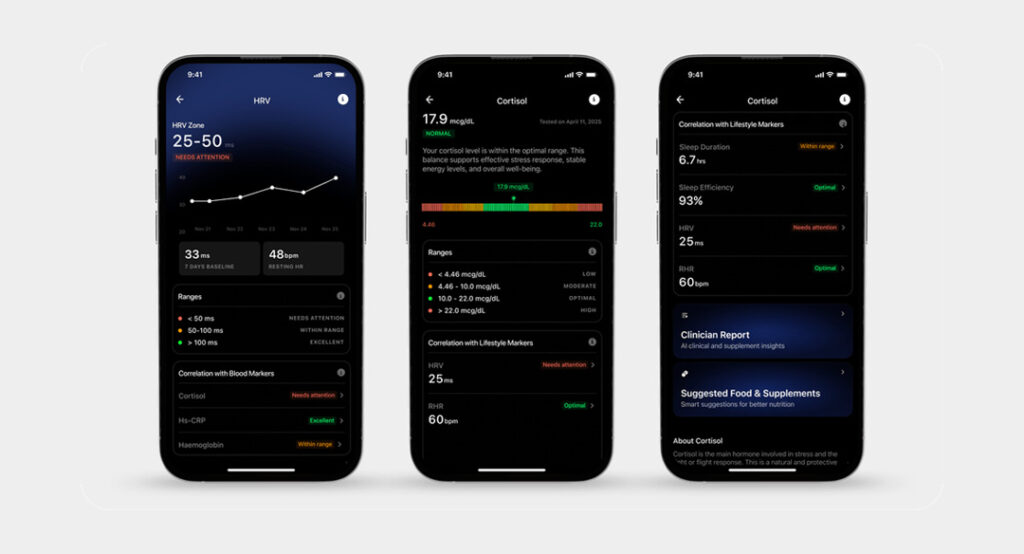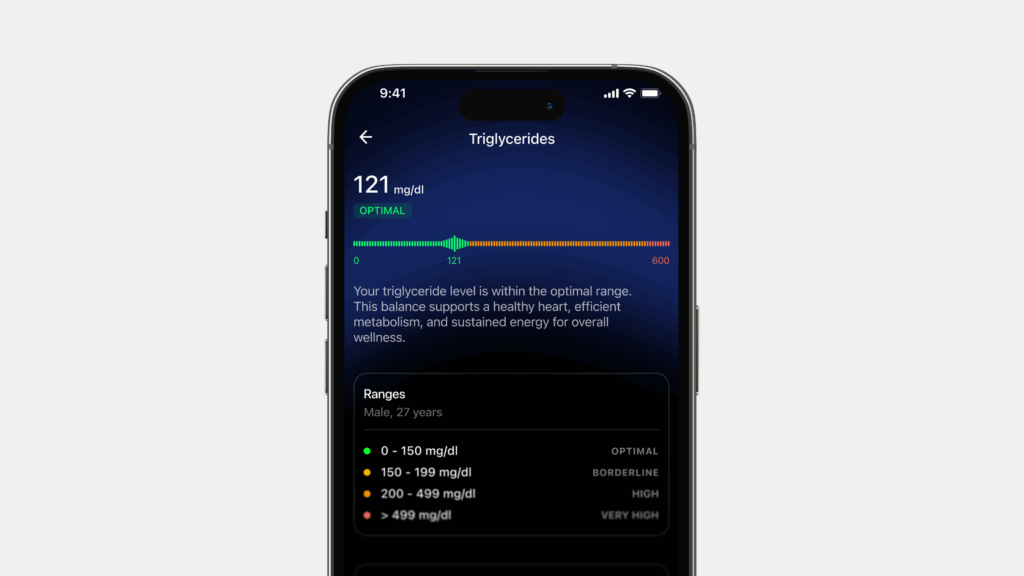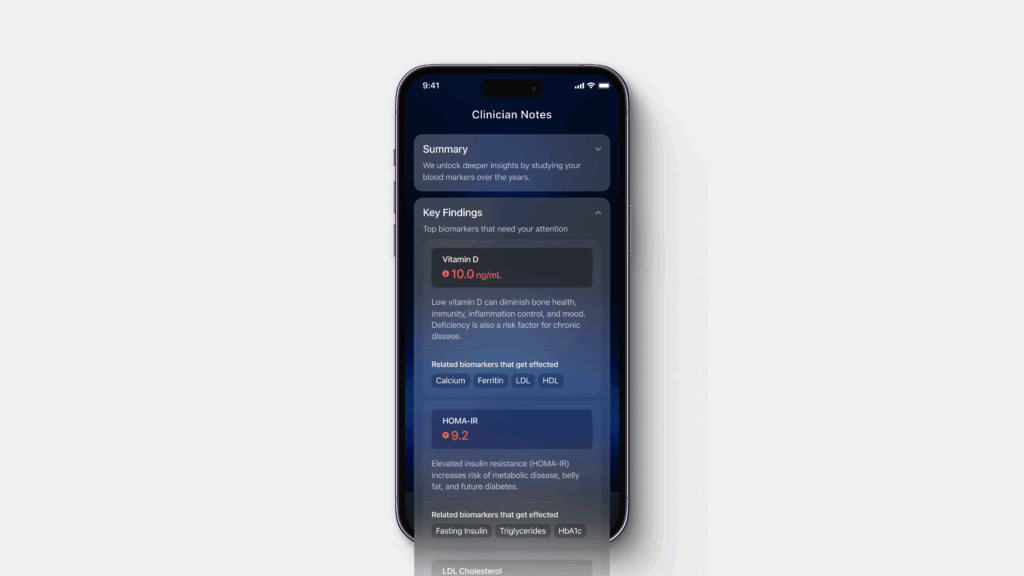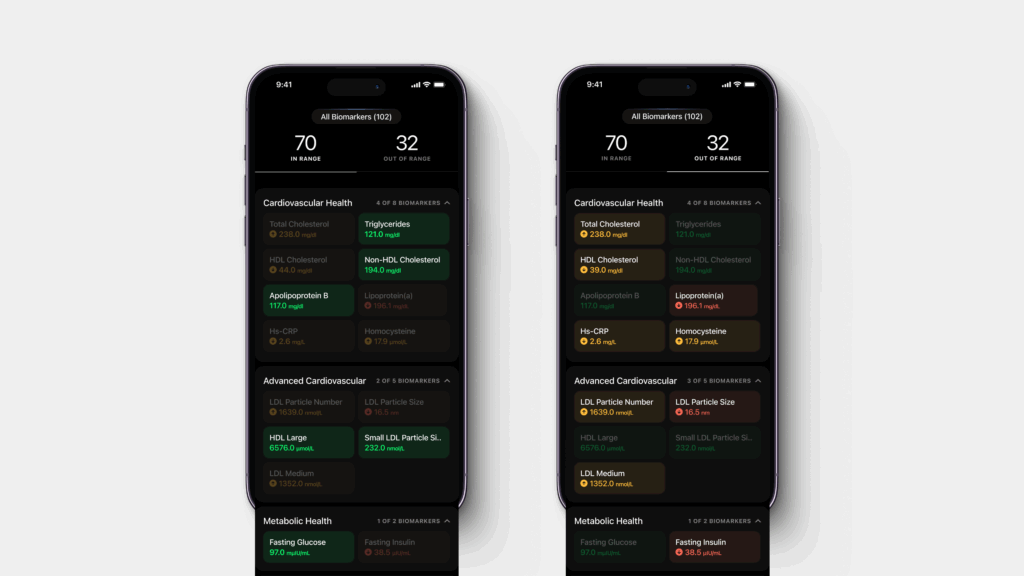Cardiovascular blood tests can reveal more about your long-term heart health than a blood pressure cuff ever could. These tests help detect early warning signs, like poor fat metabolism, inflammation, or genetic risk, that could lead to heart disease, even if you feel perfectly fine.
Ultrahuman’s Blood Vision service offers a comprehensive cardiovascular health check, including 100+ biomarkers that provide a window into your longevity, disease risk, and underlying health.
Below, we break down the most important markers and what they actually tell you about your heart.
Blood Vision cardiovascular markers and healthy ranges
| Biomarker | Healthy Range | Notes |
|---|---|---|
| Triglycerides | Under 150 mg/dL | Fat formed from excess calories; high levels signal metabolic risk |
| Total Cholesterol | Under 200 mg/dL | Sum of all cholesterol types; doesn’t distinguish good vs bad |
| HDL Cholesterol (female) | Above 50 mg/dL | ‘Good’ cholesterol that clears excess; higher is better |
| LDL Cholesterol (Medium Particles) | Under 200 nmol/L | Atherogenic particles that drive plaque; lower is safer |
| Non-HDL Cholesterol | Under 130 mg/dL | Includes all harmful cholesterol types beyond HDL |
| Apolipoprotein B (ApoB) | Under 100 mg/dL | Number of cholesterol-carrying particles; high ApoB = high risk |
| Lipoprotein(a) [Lp(a)] | Under 30 mg/dL | Genetic LDL variant tied to inflammation and clotting |
| Cholesterol/HDL Ratio | Under 7.4 | Balance of total vs protective cholesterol; lower is better |
| hs-CRP | Under 1.0 mg/L | Marker of low-grade inflammation and hidden heart risk |
| Homocysteine | Under 10 µmol/L | Amino acid linked to vascular damage if elevated |
Triglycerides
Triglycerides are a type of fat in your blood, created when your body stores unused calories, especially from sugar and refined carbs. After a meal, excess energy is packaged into triglycerides and sent into your bloodstream. Chronically high levels suggest your body isn’t handling food efficiently, and they’re often a red flag for insulin resistance and metabolic syndrome. Left unchecked, they can contribute to hardening of the arteries (atherosclerosis) and increase your risk of heart attack or stroke.
Healthy range: Under 150 mg/dL (Blood Vision standard)
Total Cholesterol
This number includes all the cholesterol in your blood: HDL (“good”), LDL (“bad”), and other lipoproteins. While it gives a rough overview, it doesn’t distinguish between protective and harmful types. A high total cholesterol number might not mean much on its own, it depends on the breakdown.
Healthy range: Under 200 mg/dL (Blood Vision standard)

HDL Cholesterol (High-Density Lipoprotein)
Often referred to as “good” cholesterol, HDL acts like a cleanup crew. It helps remove excess cholesterol from the bloodstream, carrying it back to the liver for disposal. Higher HDL levels are linked to a lower risk of heart disease, while low HDL can suggest reduced protective capacity, especially in people with metabolic issues or sedentary lifestyles.
Healthy range: Above 50 mg/dL
Moderate risk: 40–50 mg/dL
High risk: Below 40 mg/dL
LDL Cholesterol (Low-Density Lipoprotein)
LDL is the cholesterol most likely to contribute to plaque buildup in your arteries, which can narrow blood vessels and increase the risk of heart attacks and strokes. It’s sometimes called “bad” cholesterol for this reason. While lower is generally better, what really matters is how much of it you have and how many LDL particles are circulating in your blood (something standard LDL tests don’t fully capture).
Healthy range: Under 200 nmol/L.
Non-HDL Cholesterol
Non-HDL is calculated by subtracting HDL from your total cholesterol. It includes all the harmful cholesterol particles, LDL, VLDL, and others, that can contribute to artery damage. Because it captures more than just LDL, it’s considered a strong predictor of heart disease, especially in people with high triglycerides or metabolic issues.
Healthy range: Under 130 mg/dL (Blood Vision standard)s.
Apolipoprotein B (ApoB)
ApoB is a protein found on all potentially artery-clogging particles, including LDL and VLDL. Instead of measuring the cholesterol content, this test counts the actual number of atherogenic particles. Why does that matter? Even if your LDL cholesterol is within range, a high ApoB means you have more cholesterol-carrying particles in circulation, and more particles means more potential for plaque formation. This makes ApoB one of the most powerful predictors of cardiovascular risk.
Healthy range: Under 100 mg/dL (Blood Vision standard)
Lipoprotein(a) [Lp(a)]
Lp(a) is a genetically inherited form of LDL with an extra protein that makes it more likely to promote inflammation and blood clotting. Unlike other cholesterol types, Lp(a) levels are mostly fixed from birth and not influenced much by diet or exercise. High Lp(a) levels significantly increase the risk of heart attack and stroke—particularly in people who otherwise seem low-risk based on standard lipid panels.
Healthy range: Under 30 mg/dL (Blood Vision standard)
Cholesterol/HDL Ratio
This ratio compares your total cholesterol to your HDL. It helps gauge the balance between harmful and protective cholesterol in your blood. A lower ratio usually means a better profile, more “good” cholesterol relative to total cholesterol. A high ratio can indicate elevated cardiovascular risk even if total cholesterol isn’t very high.
Healthy range: Under 7.4 (Blood Vision standard)
hs-CRP (High-Sensitivity C-Reactive Protein)
hs-CRP is a marker of chronic, low-grade inflammation in the body. Inflammation plays a major role in heart disease, it can weaken artery walls, trigger plaque rupture, and contribute to clots. Even if your cholesterol is normal, a high hs-CRP level suggests there may be hidden cardiovascular risk. It doesn’t point to a specific cause but signals that your body is under some inflammatory stress.
Healthy range: Under 1.0 mg/L (Blood Vision standard)
Moderate risk: 1.0–3.0 mg/L
High risk: Above 3.0 mg/L
(based on full range data from the dataset)

Homocysteine
Homocysteine is an amino acid produced when your body processes protein. Under normal conditions, it’s broken down quickly using B vitamins (especially B6, B12, and folate). But if levels build up, homocysteine can damage blood vessels and increase clotting risk. High levels have been linked to increased risk of heart attack, stroke, and cognitive decline. Diet, genetics, kidney function, and vitamin status all influence homocysteine levels.
Healthy range: Under 10 µmol/L (Blood Vision standard)
Summary
These tests don’t exist in isolation. Together, they offer a clearer view of how well your body is handling fats, how much inflammation is present, and what hidden risks may be lurking beneath the surface.
- If you’re managing your heart health, focus on lowering LDL, ApoB, triglycerides, and inflammation (hs-CRP).
- Work to increase HDL, and if possible, get a non-HDL and ApoB reading for a more accurate risk picture.
- Don’t ignore Lp(a) — a single test can uncover inherited risk that isn’t visible in other markers.
No blood test result is a diagnosis. But taken together, these markers can help you and your doctor decide whether lifestyle changes, supplements, or medications are needed to reduce your risk of heart disease.







